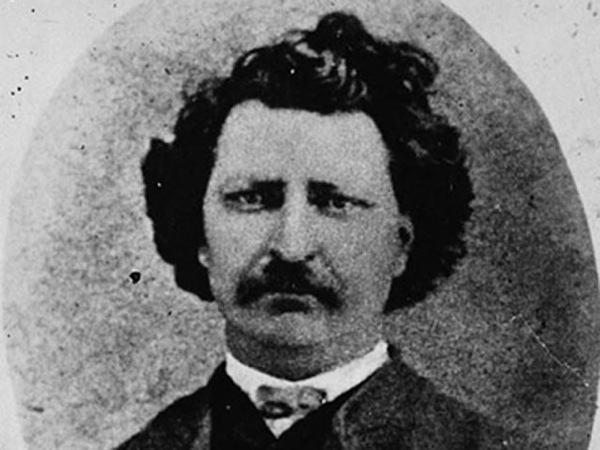Depending on which source you consult, today is either the day or the day after our Manitoban man of the day, Louis “fo” Riel captured Thomas Scott and 47 other rebels against his cause. I’d like to think that the date confusion, like all confusion, can be blamed on social media. It probably went something like this. At 11:52 p.m. on Feb. 17th, 1870 Riel tweets: “About to round up some good ol’ boys. #suckitjohna.” Then at 12:04 a.m., he instagrams a picture of Thomas Scott in some 19th-century shackles. Since nobody had their iPhone out for the video, we’ll never know exactly which minute—and therefore which day—those shackles actually touched white flesh. But whether it happened yesterday or today, it was the days to follow that really mattered.
As you know, or have probably heard but forgotten, Thomas Scott’s the guy that Riel’s new government executed. In turn, most believe that his execution is also the reason that Riel, himself, was executed by the Canadian government years later.
So what happened? According to a number of sources, Scott was no peach in prison. Historians are pretty sure he spent a good deal of his prison time insulting the Metis. In fact, some paint him as an 1870’s skinhead. Whatever it was, if his goal was to piss off his captors, it worked. On February 28th, they hauled him out of his cell and tried to beat him down a few notches. Then they pressured Riel to start the trial that ended in Scott’s execution.
You might have an image of the result in mind. There’s a famous drawing of this execution. Judging by the piece’s artistic style and merit, it seems to be the work of a 10-year-old . It’s the one with the Metis cowboy leaning forward on his right foot busting a cap into a blindfolded guy lying on his face. The gun’s got blast lines and the dead guy’s got two pools of blood. Historians found it on a proud grandparent’s refrigerator.
Understandably, said grandparent didn’t want to hang this kid’s renderings of the moments right before and after this. According to eyewitnesses, this revolver shot was fired to finish a botched execution attempt by six Metis musketeers. And supposedly, it didn’t finish the job either. It’s said that Scott’s still-living body was nailed into a casket and left out in the cold, where he continued to moan for hours. Some even say that Riel ultimately disposed of him by forcing his body through a hole in the frozen river. Try putting that on Grandma’s fridge.
Of course, we all know that ultimately, events like these are just another part of our Riel reality—a reality where:
1) Louis’ actions are essential to our national historical narrative, and
2) Riel is perhaps the ultimate symbol of our national contradictions.
In many ways, both topics have become pretty tired over the years. It seems to be a Manitoban rite of passage to muddle through a high school debate, an undergraduate seminar, and endless Winnipeg Free Press articles on the question: “Louis Riel! National hero, or national traitor?” (Spoiler alert: The hipsters in your midst will just end up sabotaging this question to wax ironically about his moustache. #speakingoftired)
But there are other contradictions embodied by Riel that get at some more pressing parts of our identity. For example: In his time, Riel was presumably fighting for regional survival, making sure the federal government’s default colonial approach didn’t do him and his in. Today, though, our federalist system is what often tries to bail out our provinces. Because our national government holds so much power, it can share the resources of an Alberta in order to save a New Brunswick. Where Riel’s regionalism fought to protect the have-nots from the haves, the ultimate success of federalism has arguably achieved that. You might say that Louis’ goal (regional survival) won because his approach (regional sovereignty) lost. How’s that for contradiction?
Of course, both perspectives are pretty Anglo-centric ways of seeing it. If Riel’s ultimate goal was Metis/indigenous survival, and provincial sovereignty was just a means to that end, then neither the provincial nor the federal governments would get him there. Indigenous sovereignty and survival have mostly just been trampled by both.
So how do we synthesize these contradictions? As always, of course, with Riel. Canada’s roots are colonial, which is what Riel was fighting against. Thanks to the federalist impulses in that colonialism, though, Canada’s present is more egalitarian, which is what Riel was fighting for. And yet, Canada’s future lies in finally overcoming our colonialism entirely, which is what Riel’s legacy should inspire us to fight for still. Riel’s resistance can simultaneously be a symbol of who we were , who we are, and who we need to become. So sure, let’s take today to celebrate that past and this present. But let’s also remember that like Louis’ legacy itself, today’s celebration will ultimately be measured mostly by the tomorrow it becomes.
___
Peter J.H. Epp teaches teens to read literature, write creatively, act boldly, talk politics, think harder about their religion, and generally hone the skills that don’t pay the bills.
You can follow him on the streets of Gretna. Or just email him at p_epp@hotmail.com.
